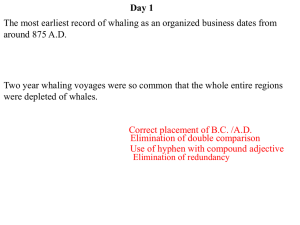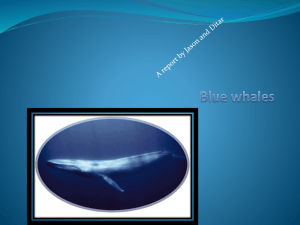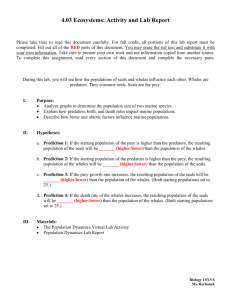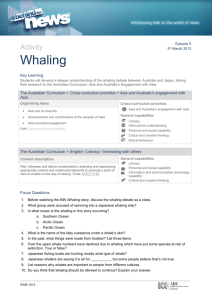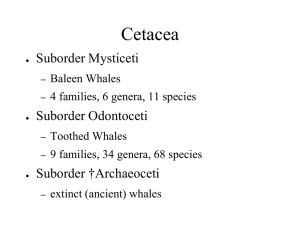Module 4
advertisement
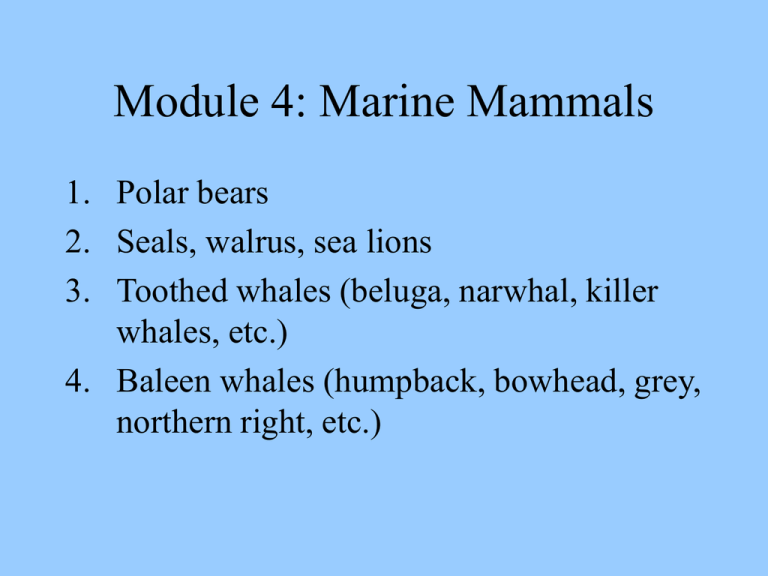
Module 4: Marine Mammals 1. Polar bears 2. Seals, walrus, sea lions 3. Toothed whales (beluga, narwhal, killer whales, etc.) 4. Baleen whales (humpback, bowhead, grey, northern right, etc.) Key Biological Traits • • • • Large space requirements Low reproduction potential Long life Risk of bioaccumulation of organic pollutants • Sensitive to over exploitation Management Difficulties • Poor estimates of population size and vital rates (reproduction, survival, dispersal) • Inter-jurisdiction distribution • Difficult to regulate harvest (subsistence and commercial) • Highly political in nature Terms and Concepts Cetaceans – Mammal species such as whales, dolphins, and porpoises IWC – International Whaling Commission MMPA – Marine Mammals Protection Act (U.S.A.) Polar Bears Polar Bear Overview • Depending on seals (ringed seals and bearded seals) • Distributed in distinctive stocks • Subsistence/cultural hunting • Subject to an international agreement on conservation • Token sport hunt (in Canada only) Ringed Seals Ringed Seal Overview • Widely distributed (5 million) • Feed on fish (Arctic cod) and “Arctic shrimps” • Most important species for subsistence hunting (Inuit) • Most important for clothing • Fairly resilient to harvest Distribution of Ringed Seals Harp Seal Distribution of Harp Seal Harp Seal Overview • • • • Commercial hunt in spring (under quota) Increasing in population size May affect fish populations Source of debate Bearded Seal Bearded Seal: Overview • • • • Heterogeneous distribution Like thin ice, or ice flow Secondary prey for polar bears Excellent skin for ropes and moccasins Walrus Walrus Distribution Walrus Overview • • • • • • Two stocks: Atlantic and Pacific Source of ivory (art work) Gregarious in distribution Mollusk eaters (some prey on seals) Excellent skins for ropes! Hunt in Alaska highly regulated Beluga Whale Beluga Whale Beluga Whale Populations: Circumpolar Beluga Whale Populations: Canada Beluga Whale Overview • Large movements (distinct stocks) • Important for subsistence hunting (delicacy food) • Hunted under quotas (by local people) • Rich in Vitamin C (scurvy) • Major conservation issues in some regions Narwhal Narwhal: Overview • Large seasonal movements • Hunted for food and tusks • Traditional hunt only (under quota) Narwhal Populations Other Whales Other Whales: Overview • ~50 humpbacks harvested per year in Chukchi Sea by Alaska Inuit • Few (1-2) bowheads harvested by Eastern Arctic Inuit • Subsistence hunt continued to be impaired by past overuse of stocks (commercial whaling) Marine Mammals - People • Long term dependency of northern people on marine mammals (seal hunters) • Recurring issues of conservation and public debates Commercial Whaling Phase I: The Basque Fishery (Spanish) – 1300 to late 1500 A.D. Overview • Focused on right whales (local depletion of coasts of Europe) • Expanded up to Grand Banks near Newfoundland • By late 1600s, right whales were almost exterminated Phase II: The Atlantic Arctic Fishery Overview • • • • Focused on bowhead whales in North Atlantic Early 1600sLate 1800s Involved many shore stations Move from Svalbard, Davis Strait, Baffin Bay, to North water • Risky but lucrative (£3500 a ton for whale bones) • In 1910, 10 whaling ships hunted the Arctic: 18 pilot whales, 389 belugas, 1697 walruses, 4549 seals, 242 polar bears, and no bowhead whales Phase III: Pacific Arctic Fishery Overview • U.S. whalers shift attention to North Pacific • First, Pacific northern right whales (largely depleted by 1850) • Next, Pacific bowhead whales in Bering Sea (150200 whaling ships, up to 2700 bowheads killed in 1852) • First whaling ships with steam engines pushed hunt in North Shores of Alaska (Beaufort Sea) Overview • Market collapsed in 1912, which lead to an end of whaling in the Arctic (which “saved” humpbacks) • In SE Alaska, whaling ended in 1930s • In 1937, first international whaling agreement Required Reading “Thar She Blows: Whaling in the Yukon and Alaska” (handout) Modern “Whaling” Case Study: Steller Sea Lions Conservation Issues • Slow recovery of most baleen whale stocks (except gray whales) • Impair acceptance of traditional hunts by general public • Atlantic right whales at great risk • Management of tourism North Atlantic Right Whale





